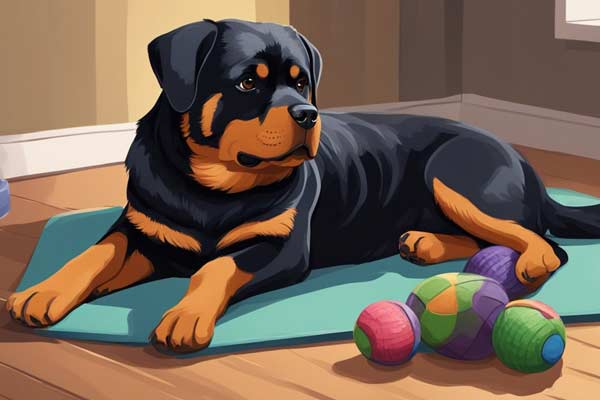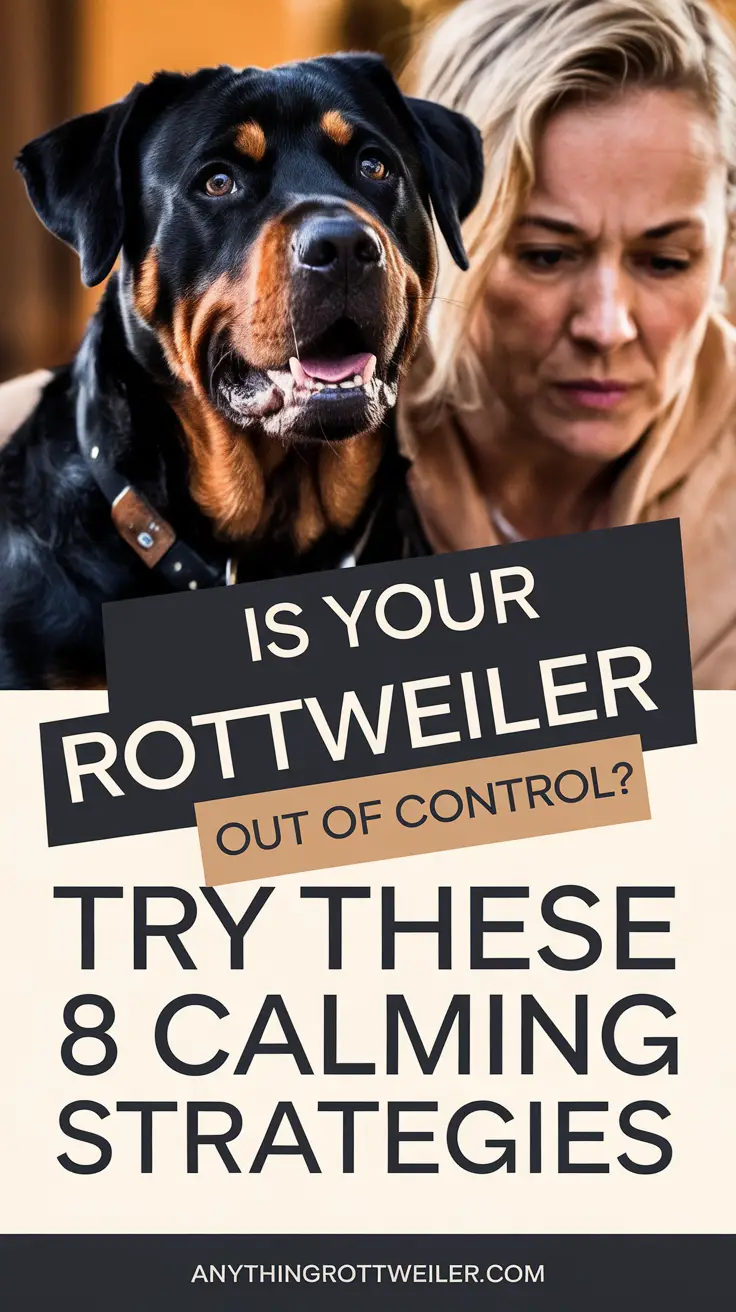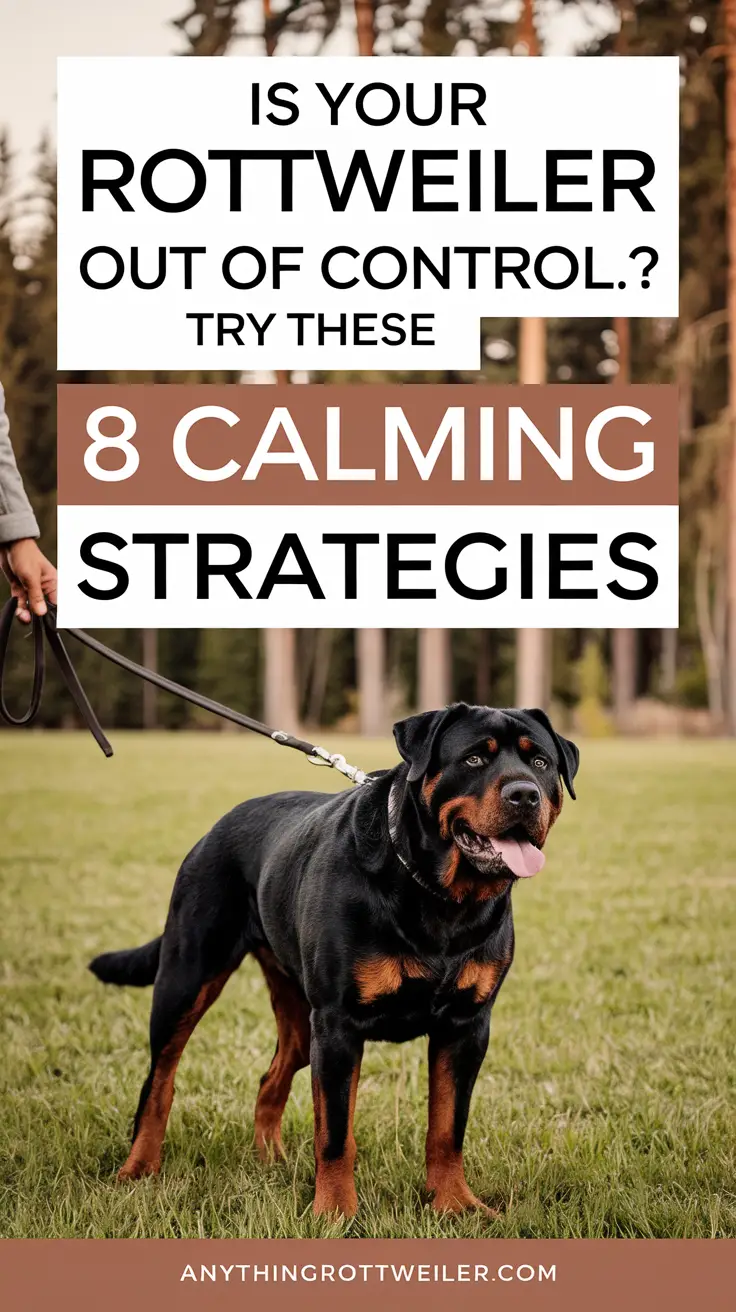Rottweilers are known for their protective and loyal nature, making them a popular choice for pet owners. However, their strong personalities and high energy levels can sometimes lead to behavioral issues, including aggression and anxiety.
Learning how to calm down a Rottweiler is essential for both the safety of the dog and those around them.
Proper training and socialization are one effective way to calm a Rottweiler. Consistent exercise and mental stimulation can also help promote a balanced and calm temperament in Rottweilers.
Additionally, various techniques and tools can be used by pet owners to soothe their Rottweilers when they become anxious or agitated.

Recognizing Rottweiler Behavior
Rottweilers are typically recognized for their composed and self-assured nature, yet they might exhibit aggressive tendencies when not given the right training. It’s crucial to grasp and be aware of their behavior to avert undesired situations.
Hyperactivity is common in Rottweilers, especially when they are young. They have a lot of energy and need regular exercise to prevent destructive behavior. If a Rottweiler is growling or showing signs of aggression, it may be due to fear or anxiety.
Separation anxiety, sound anxiety, and travel anxiety are common issues that can cause a Rottweiler to become anxious and display destructive behavior.

To stop a Rottweiler from being aggressive, getting them used to people and other animals when they’re young is essential. This will help them feel comfortable in new situations. Also, you should teach them to set rules and prevent bad behavior.
If a Rottweiler displays aggressive behavior, it is vital to remain calm and avoid any aggressive behavior.
It is best to give them space and remove any potential triggers. If the behavior persists, it might be a good idea to consider contacting a professional trainer or behavior expert for assistance.
The Importance of Training
Training is crucial for a Rottweiler’s development and temperament. A well-trained Rottweiler is more responsive and obedient, making it easier to calm down when necessary.
Proper training helps a Rottweiler understand boundaries and expectations, which can reduce anxiety and hyperactivity.
Commands are a vital part of training. Rottweilers should learn basic commands such as “sit,” “stay,” “come,” and “heel.” Obedience training should be a part of Rottweiler’s routine from an early age.
Using positive reinforcement is a very successful training approach. Rewarding a Rottweiler with treats or praise for their excellent behavior motivates them to continue that behavior.
Discipline is also essential in training a Rottweiler. Consistent and fair discipline will help a Rottweiler understand when it has done something wrong. However, avoiding harsh or physical punishment is crucial, as this can damage the bond between the Rottweiler and its owner.
A well-trained Rottweiler will be more responsive to its owner’s commands, making it easier to calm down when necessary. Training also helps a Rottweiler understand what is expected, which can reduce anxiety and hyperactivity.
Managing Anxiety and Fear
Like many other breeds, Rottweilers can experience anxiety and fear in certain situations. To effectively manage your Rottweiler’s anxiety and fear, it’s crucial to grasp the underlying reasons for these emotions.
Rottweilers often experience a type of anxiety known as separation anxiety. This happens when the dog feels worried or upset when it is away from its owner or main caregiver. To handle separation anxiety, it’s crucial to slowly get your dog used to your departures.
You can achieve this by starting with short absences and then gradually extending the time. Giving your dog a relaxing chew toy or using a pheromone diffuser can also help reduce its anxiety.
Another type of anxiety that Rottweilers may experience is sound anxiety. This occurs when the dog becomes anxious or fearful in response to certain sounds, such as thunderstorms or fireworks.
To manage sound anxiety, creating a safe and comfortable space for your dog to retreat to during these events is crucial. Providing your dog with a calming chew or playing soothing music may also help to ease their anxiety.
Travel anxiety is another common type of anxiety in Rottweilers. It occurs when the dog becomes anxious or fearful during car rides or other forms of travel. To manage travel anxiety, it is important to gradually desensitize your dog to the experience of traveling.
You can achieve this by starting with brief car rides and then progressively extending the length of the journeys. Additionally, giving your dog a soothing chew or using a pheromone diffuser might assist in alleviating their anxiety.
Physical and Mental Stimulation
One of the best ways to calm down a Rottweiler is to provide them with enough physical and mental stimulation.
Rottweilers are energetic dogs that require regular exercise and play to maintain their well-being and happiness. When they don’t receive adequate activity, they can become fidgety and bored and may even engage in destructive behavior.
To help your Rottweiler calm down, you should ensure that they get enough exercise every day. This can include walks, runs, hikes, or trips to the dog park.
Regular exercise will help burn off excess energy and keep your Rottweiler physically fit. You can also play games with your dog, such as fetch or hide-and-seek, to provide them with mental stimulation.
In addition to exercise and play, you can also provide your Rottweiler with mental stimulation. This can include puzzle toys, interactive games, and obedience training.
Mental stimulation can help channel your dog’s energy and improve their calmness. You can also teach your Rottweiler new tricks and commands to keep their mind engaged and challenged.
It’s important to note that every Rottweiler is different; some may require more or less exercise and mental stimulation than others. You should always consult with your veterinarian to determine the best exercise and activity plan for your dog.

Creating a Calming Environment
Creating a calming environment is essential to help a Rottweiler relax and calm down. Here are some tips to help create a calming environment for your furry friend:
Comfort
Providing a comfortable space for your Rottweiler is crucial to help them feel relaxed. Make sure your dog has a comfortable and snug place to rest. It’s also essential to keep the temperature in the room comfortable for your Rottweiler. It can make them feel uneasy and restless if it’s too hot or cold.
Routine
Creating a regular daily schedule for your Rottweiler can enhance their sense of security and calm. Strive to stick to a set routine for feeding, walking, and playtime. This will familiarize your dog with a predictable pattern, decreasing their anxiety.
Crate Training
Crate training is a helpful method for establishing a secure and peaceful area for your Rottweiler. Start by introducing the crate gently and positively.
Offer treats and use positive reinforcement to guide your dog into the crate. As your Rottweiler grows comfortable with it, the crate can become a comforting retreat for them to unwind and find peace.
Calming Aids
There are several calming aids available that can help your Rottweiler relax. Some options include:
- Calming sprays or diffusers that release pheromones to reduce anxiety
- Herbal supplements that promote relaxation
- Anxiety vests that provide gentle pressure to help your dog feel more secure
It’s essential to consult with your veterinarian before using any calming aids to ensure they are safe and effective for your Rottweiler.
Proper Nutrition and Diet
Proper nutrition and diet are essential for any dog, including Rottweilers, to maintain good health and well-being. Rottweilers require a well-balanced diet high in protein and low in sugar to maintain their muscle mass and energy levels.
Feeding a Rottweiler involves considering their age, weight, and activity level. For puppies, it’s best to feed them four times a day, while adult Rottweilers can switch to two meals as they grow.
A balanced Rottweiler diet should have 25-30% protein from chicken, fish, lamb, beef, and eggs.
It’s crucial to ensure that the food you consume contains the essential vitamins and minerals like calcium, phosphorus, and vitamin D, which are needed to promote strong and healthy bones.
When picking food for your Rottweiler, choose options without fake stuff like preservatives, colors, or flavors. Also, avoid foods with lots of sugar or corn syrup to help your Rottweiler stay fit and healthy.

Role of Toys in Calming Rottweilers
Toys play a vital role in calming Rottweilers. They provide a distraction and an outlet for their energy, which can help reduce their anxiety and stress levels. Puzzle toys, in particular, can effectively keep Rottweilers mentally stimulated and engaged, which can help prevent destructive behavior.
When choosing toys for a Rottweiler, it is vital to consider their size and strength. They need toys that are durable and can withstand their powerful jaws. Look for toys made of sturdy materials like rubber or nylon.
Puzzle toys are an excellent option for Rottweilers because they require problem-solving skills and mental stimulation.
These toys can help keep Rottweilers occupied for longer periods, which can help reduce their anxiety levels. Some puzzle toys also dispense treats, which can provide positive reinforcement for good behavior.
Engaging in playtime with Rottweilers is essential. It helps them release extra energy and strengthen their connection with their owners. Routine play sessions are effective in lowering their stress and encouraging relaxation.
Activities like playing fetch or a friendly game of tug-of-war are fantastic ways to interact with a Rottweiler and offer them a healthy way to use their energy.
Handling Aggression
Rottweilers are famous for their protective instincts, but these instincts can occasionally turn into aggression.
It’s important to realize that when dogs become aggressive, it’s often due to fear, anxiety, or a lack of social interaction.
If your Rottweiler displays aggressive behavior, acting promptly is crucial to prevent potential harm to people or other animals.
One of the first steps in handling aggression in a Rottweiler is to identify the underlying cause. This can often be done by observing the dog’s body language and behavior.
Aggression signs may include growling, barking, snarling, and biting. Warning signs, such as stiff body posture and intense staring, may precede an aggressive outburst.
Remaining calm and assertive is vital to calm an aggressive Rottweiler. Avoid yelling or punishing the dog, as this can escalate the situation.
Instead, speak to the dog in a strong and confident tone. It’s essential to make eye contact with the dog as well, as it helps build trust and show positive intentions.
To prevent aggression in Rottweilers, socializing them is vital. Introducing the dog to different people, animals, and places can reduce fear and anxiety.
Enrolling your dog in training and obedience classes can also be helpful. This will teach them proper behavior and reinforce positive interactions.
If your Rottweiler shows extreme aggression, it’s essential to consider getting help from a professional. A vet or an animal behavior expert can provide valuable advice and support in handling your dog’s behavior and identifying potential medical concerns.
Socialization of Rottweilers
Ensuring your Rottweiler grows up well-adjusted and content is heavily dependent on socialization.
This means introducing your dog to diverse individuals, other animals, and different surroundings while instructing them on proper behavior in various scenarios.
The socialization process should start as early as possible, ideally between 3 and 14 weeks of age, when puppies are most receptive to new experiences and less likely to develop fear or aggression toward unfamiliar people, animals, and environments.
When socializing your Rottweiler, exposing them to various people, including strangers of different ages, genders, and races is crucial.
This will help your dog learn to be comfortable around people of all kinds and prevent them from becoming overly protective or aggressive towards strangers.
Exposing your Rottweiler to other animals, such as dogs, cats, and livestock, is also essential to teach them how to behave appropriately around other animals.
During the socialization process, always supervise your Rottweiler and ensure that they are behaving appropriately.
Suppose your dog shows fear or aggression towards a person or animal. In that case, it is vital to remove them from the situation and seek the help of a professional dog trainer or behaviorist.
In addition to exposing your Rottweiler to different people and animals, it is also essential to expose them to different environments, such as parks, beaches, and busy streets.
This will assist your dog in acquiring proper behavior in various situations and avoid excessive anxiety or reactivity when in unfamiliar settings.
The Role of Positive Reinforcement
Using positive reinforcement is a successful method for soothing a Rottweiler.
This technique revolves around praising and rewarding good behavior, which motivates the dog to continue behaving well in the coming days.
Rewards may comprise treats, affectionate petting, and speaking in an encouraging tone.
When using positive reinforcement to calm down a Rottweiler, it’s essential to be consistent and clear. The dog needs to understand what behavior is being rewarded and why.
For instance, when the dog makes too much noise by barking, the owner can reward it when it’s quiet.
In addition to rewarding good behavior, positive reinforcement can also be used to redirect the dog’s energy. For example, if the dog jumps up on people, the owner can redirect the dog’s attention to a toy or treat on the ground.
It’s important to note that positive reinforcement should not be used to reinforce negative behavior. For example, if the dog is growling or biting, the owner should not reward the dog for stopping. Instead, the owner should remove the dog from the situation and address the underlying cause of the behavior.
Professional Help and Veterinarian Care
If a Rottweiler is exhibiting excessive hyperactivity or anxiety, it may be necessary to seek professional help. A veterinarian or dog behaviorist can provide valuable insights and guidance on how to calm down a Rottweiler.
If your Rottweiler is hyperactive, you can take a few steps to help them. First, visit a vet to rule out any underlying health issues. The vet might recommend medication to calm your dog, so follow their instructions carefully.
You can also consult a dog behaviorist to address your Rottweiler’s hyperactivity. They’ll provide training and behavior modification techniques to help calm your dog and identify anxiety or hyperactivity triggers. Make sure to choose an experienced behaviorist.
Remember, seeking professional help for your Rottweiler isn’t a sign of weakness as a pet owner. It’s a responsible way to ensure your dog’s well-being and build a strong bond between you and your furry friend.
Caring for a Rottweiler Puppy
Rottweiler puppies are energetic and playful, requiring attention and care. Here are some tips for caring for your Rottweiler puppy:
Playtime
Rottweiler puppies love to play, and playtime is essential to their development. It helps them to socialize, learn new skills, and burn off excess energy. Ensure your puppy has plenty of toys and playtime throughout the day.
Exercise
Consistent exercise is essential for maintaining the health and well-being of your Rottweiler puppy. Engage in activities like walking, running, and yard play sessions. Nonetheless, it’s essential to avoid excessive exercise that might lead to joint issues in the future.
Attention
Rottweiler puppies crave attention and affection from their owners. Spend time with your puppy daily, playing, cuddling, and training. This will help to build a strong bond between you and your puppy.
Training
Training is an essential part of caring for a Rottweiler puppy. Start training your puppy early, using positive reinforcement techniques. This will help to establish good behavior and prevent any bad habits from forming.

